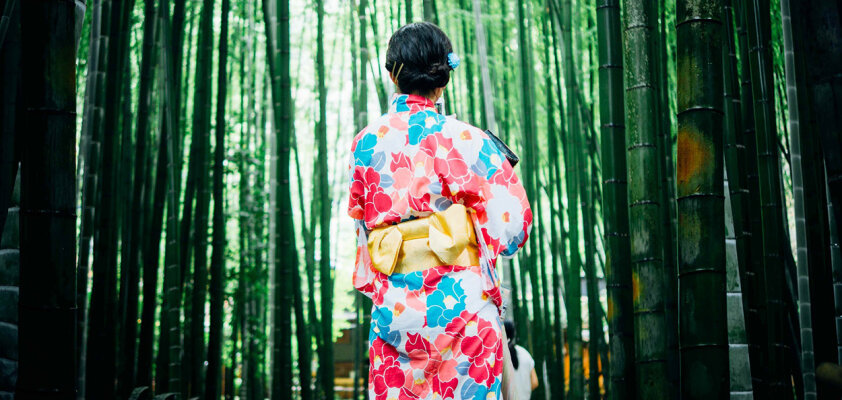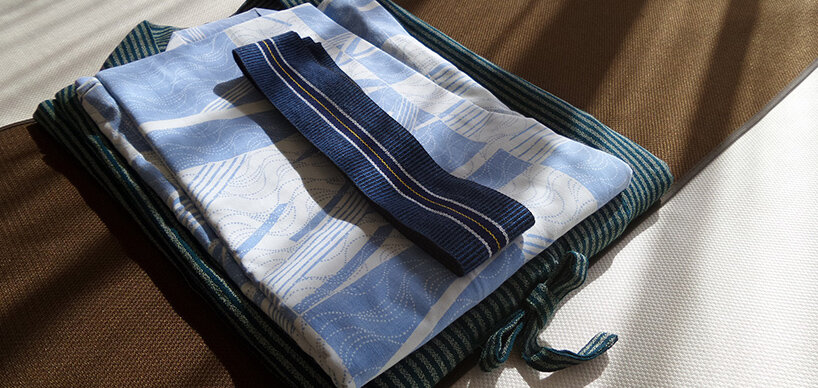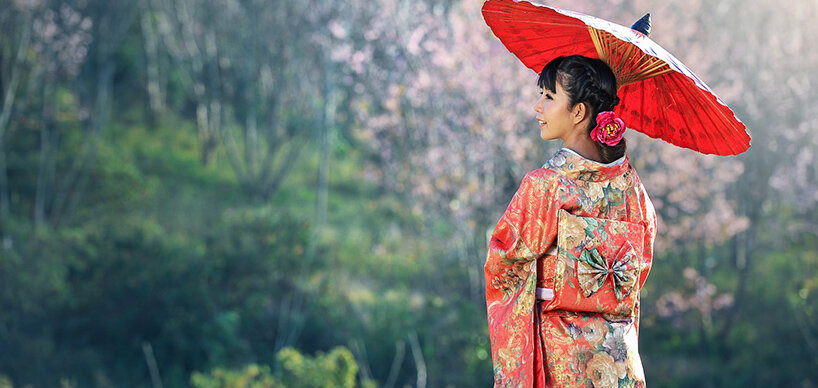Kimono - Timeless Japanese Fashion

Kimono in Japanese translates to “thing to wear”. However, as straight and simple as it may appear, this garment made of silk or cotton is much more complex than one might think. Whether for festive occasions, ceremonies, weddings, or everyday wear – various types of kimonos make it suitable for any occasion. What lies behind the kimono, and what makes it so special?
Kimono: A living tradition in Japan
As old as the kimono may appear, it has only been present in Japan since the 15th century. During the Muromachi era, wearing a kimono was reserved for the samurai, but in times of peace, merchants and artisans in Japan increasingly displayed their prosperity through their clothing. The kimono became a status symbol. In the Edo period, which began in 1603, rules were established on how to wear a kimono, and they still apply today. Since then, the form and design have not changed significantly.
Although the kimono began to decline since the 1920s, even today, in an era of advanced technology and bustling metropolises, many Japanese still wear kimonos. Not only for celebrations and events but also in daily life, you can see many kimono wearers on trains, in stores, and on the streets.
One reason for this is that the coexistence of modernity and tradition in Japan is not uncommon. For sumo wrestlers and geishas, wearing a kimono in daily life is part of their profession. Additionally, a lightweight yukata, the informal cotton variant, is the most practical garment for the hot, humid Japanese summer. Originally, it was a type of robe for the nobility worn to public baths (Yu stands for "bath").
When booking a room in a traditional Japanese inn (ryokan), you will always find a yukata in the closet that you can wear inside the building. Often, you wear geta, light wooden sandals, with the yukata. You can also put on a kind of jacket called haori over the yukata. Haori are usually hip-length, monochromatic, and have been worn by women only since the last century.

The right kimono for all occasions
However, properly donning a kimono is an art that many in Japan do not fully master. Therefore, many Japanese choose to take special courses, especially when they plan to marry in a kimono. Additionally, there are almost a dozen different types of kimonos, each varying depending on the wearer and the occasion. Married and unmarried women, men, and children each receive a different kimono. Moreover, one should dress according to the formality of the event. Here is a brief overview of the types of kimonos:
- Tomesode: Formal kimono for married women, either black or in bright colors
- Houmongi: Semi-formal kimono with continuous patterns on the sleeves and below the waist, suitable for outings or ceremonies and visits
- Tsukesage: Semi-formal kimono with subtle patterns on the sleeves and below the waist. Slightly less formal than Houmongi
- Iromuji: Plain-colored kimono without patterns, worn especially by older women for celebrations and tea ceremonies
- Furisode: Formal kimono with wide sleeves and colorful patterns for unmarried women
- Komon: Kimono with repeating patterns over the entire fabric for younger women and informal occasions
- Shiromuku: White kimono worn at weddings. Often found together with Wataboshi or Tsunokakushi, a special type of hood
- Uchikake: Wedding kimono embroidered with gold and silver, with woven patterns and a long train, worn with special hair accessories
- Yukata: Light, informal kimono for everyday wear, especially suitable for the summer months. It can be worn by both women and men
- Montsuki: Kimono with a family crest for men, especially worn at weddings and other formal occasions
- Mofuku: Black kimono worn for funerals and memorial days

If that's not complex enough, there are also combinations of different types worn, especially for informal occasions. In Japan, even children wear kimonos for celebrations. Particularly on the Shichi-go-san day on November 15th, many Japanese children gather at temples with their parents to pray for a happy life year when they turn three, five, or seven years old.
Although many variations of traditional clothing are intended for women, there are also kimonos for men – albeit with less diversity. Men's kimonos are considerably simpler and darker, with subtle patterns. Often, the family crest, Kamon, can be found on them. For formal occasions, men wear a Montsuki along with traditional Hakama. The latter comes in the form of trousers or a skirt, and it can also be worn by women. Especially for graduation ceremonies, young women often like to wear a colorful, elaborately patterned Furisode kimono with Hakama.
World of symbols, colors and patterns
Not only the form but also the color plays a crucial role in the choice of a kimono. For example, simplicity is required during the tea ceremony, and the plain-colored Iromuji (literally "unpatterned color") is often worn, as it does not distract from the ceremony. Traditionally in Japan, colors have practical meanings, such as the color blue being believed to protect against snakes and insects. Today, more emphasis is placed on aesthetics, the situation, and the wearer. The lining also differs: for women, you often find white or red lining, while for men, it is often dark blue.
Another reason why one should have multiple kimonos in the wardrobe is the season. Cherry blossom patterns are found on kimonos in spring, the colors become darker and the fabrics heavier in autumn. In winter, the material is naturally coarser than in summer, and the kimono can be additionally equipped with a fur collar.
The patterns found on a kimono are predominantly inspired by nature. The motifs have symbolic meanings: butterflies for love, bamboo for endurance and adaptability, dragonflies for strength and joy. The crane, especially, a symbol of a happy, long life, is found on many kimonos. The more meaningful the pattern, traditionally, the higher the status of the wearer: for instance, the phoenix as a symbol of luck marked powerful samurai.
Especially in theater and the arts, the design of a kimono plays a significant role. With the color, pattern, and cut of extravagant costumes, the Kabuki actor can express his role. One just needs to be able to read the signs: colorful and delicate patterns and fabrics indicate a younger role, red kimonos symbolize passion and supernatural powers. In later eras, kimonos became more elaborate and intricate, reflecting in the costumes.
Wearing a kimono correctly - an art in itself
Often, these garments are so complex that one needs someone experienced to help with putting them on. The complete styling can take over an hour depending on the difficulty. You must put on at least three pieces: the under-kimono Nagajuban, the upper kimono layer, and the sash called Obi. The two layers of the kimono are tied together with the help of Koshi Himo, a thin belt. It is essential to put on the kimono with the left side up – the right side is only up for funerals. Moreover, it is considered good etiquette to fold the kimono under the sleeves once (Ohashori), which is why a slightly too long model is always chosen. The kimono should always end at the ankles.
A Geisha learns, among other things, how to put on a kimono during her training. She also has her own style of clothing: the special kimonos called Susohiki are more simple and have subdued colors. These kimonos are so long that they need to be elegantly gathered while walking. On the other hand, Maiko, the apprentice Geishas, wear the Hikizuri. This one is much brighter and more colorful, and combined with the splendid hair ornaments, gives the Maiko a younger and more playful appearance. Their shoes (Oboko) are also higher and more eye-catching than those of a Geisha.
If you've ever wondered about the small gaps between steps in some places, especially gardens, in Japan: try taking big steps in a kimono – it won't work. The kimono is designed for a slow, deliberate walk. Shuffling is not considered bothersome in Japan but rather elegant.
Accessories: A concept from head to toe
A kimono consists not only of the silk garments but also of numerous accessories that go along with it. The Obi belt also varies depending on the occasion and can be tied in different ways: a wider belt is found in ceremonies, while it is kept thinner for everyday wear. Today, a particular method of tying is mainly taught, which involves several components. Firstly, there is the sash itself, the Obi pillow Obi-makura, and the Obi-age, a silk scarf that covers the pillow. A braided cord called Obi-jime secures the entire arrangement, and the belt is adorned with the Obi-dome, a decorative pin. The knot in the Obi is called Musubi.
What do you wear on your feet in Japan? The thong sandals made of silk, fabric, straw, or lacquer, worn with the kimono, are called Zori. Tabi socks, usually white and split at the big toe, are practical but obligatory only for women. They can often be closed over the heel with the help of eyelets and hooks.

Lastly, the kimono also includes the bag and hair accessories like hairpins adorned with colorful artificial flowers. The colors must be coordinated: for example, with the wedding kimono Shiromuku, all accessories including the bag are white. The wide-cut sleeves are, by the way, another characteristic of some types of kimono and yukata: you can also store items in them, like in a pocket – practical for the trip to the public bathhouse in earlier times.
Japanese fashion art that knows its price
For birth, every child in Japan receives a kimono as a gift, meant to accompany them on the path to a happy and successful life. However, a young woman in Japan wears her first formal kimono for the Coming of Age ceremony, which takes place annually on the second Monday of January. On this day, all young Japanese who have just turned 20 celebrate entering adulthood. Families can expect significant expenses on this occasion, as a good kimono can cost thousands of euros. Young men have it easier, as they only need a suit for this event. Renting a kimono is a more affordable option for many Japanese on other occasions, and it's also something tourists can use to gain an authentic Japanese experience. But what exactly makes these garments so expensive?
Aside from silk and other often handwoven fabrics used in making kimonos, the technique also plays a significant role. Embroideries, hand-painted patterns, intricate weaving techniques, and artistic prints turn kimonos into masterpieces crafted over a long period with great dedication. Techniques involving rice starch paste, silver foil, and templates made of special paper may also be used. For each step of the process, of which there are almost 1000, a different artisan is responsible, some of whom undergo decades-long training.
To preserve these artworks, kimonos should only be stored folded and, if at all, washed by hand with lukewarm water. Care and cleanliness are essential when handling kimonos. While machine-made kimonos from synthetic fabrics are available today for a few hundred euros, those looking for a high-quality, traditional garment must be prepared to invest a considerable amount of money.
One of the rewards for such an investment could be becoming the Kimono Queen: at the competition in Asakusa, Tokyo, the lady with the most beautiful kimono is awarded a prize, including opportunities like modeling. However, even if you're not vying for the crown, every visit to Japan offers a chance to admire the beauty of these traditional garments – and even try them on yourself. Let yourself be enchanted by the magic of the kimono.











-from-the-yakiyaki-grill-pan.jpg)




